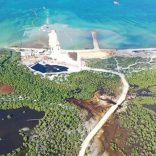Mozambique: Niassa Lion Project resumes activities in the Niassa Special Reserve
Tropical storm #Dineo closes in: Storm predictions in Mozambique, affected SA areas identified

South African Weather Service / RGB composite image (c) EUMETSAT 2017 / The tropical low, squarely within the Mozambique Channel at 09:00 local time on Monday morning, 13 February, showing some degree of spiral banding, mostly on the eastern side of the system. Southern Mozambique is currently under the influence of dry, descending air on the periphery of the tropical low and thus remains virtually cloud-free.
A tropical storm #Dineo is moving in towards the coast of Mozambique and the northernmost parts of SA’s east coast, the South African Weather Service has confirmed.
According to the SA Weather Service, “The weather system has the potential to result in severe weather impacts over the north-eastern parts of the country later this week,” especially in parts of the Mpumalanga and Limpopo provinces.
When the storm passes over Mozambique on Thursday and Friday, 16 and 17 February, the SA Weather Service predicts that the north-eastern parts of South Africa, including parts of the Kruger National Park, may experience heavy rain as well as localised flooding.
“The most likely areas to be affected include the Ehlanzeni district in Mpumalanga as well as Mopani and Vhembe districts in Limpopo. The heavy rains is also likely to spread to other districts in Limpopo.
Storm predictions in Mozambique
Weather conditions in the Mozambique Channel continue to be hot and humid, with light winds in the atmosphere, whilst sea-surface temperatures exceed 30°C over the eastern part of this region, adjoining the Mozambique Channel, the SA Weather Service confirms.
These are all favourable conditions for the growth and intensification of tropical lows.
It is therefore “expected that it will follow a predominantly south-westerly track over the next few days, whilst intensifying further, to reach the severe tropical storm (winds of 89-117 km/h) on the morning of Wednesday, 15 February, when it is projected to be just seawards of Massinga and Inhambane on the coastline of southern Mozambique.
“Thereafter, during the period Wednesday to Friday, it is expected to move into the inland region of southern Mozambique, bringing heavy tropical rain to the sub-region,” the SA Weather Service says.
The tropical system is likely to introduce a range of severe weather to parts of southern Africa later in the week, including heavy rainfall, flooding and possibly wind damage along parts of the southern Mozambican coastline.
Likely to weaken at landfall
Despite the warning, the SA Weather Service says that current projections DO NOT expect the system to intensify to the tropical cyclone stage before it makes landfall. They also note that “all landfalling tropical systems inevitably begin a rapid process of weakening and decay once they are overland and deprived of the energy provided by warm ocean water.
“It can therefore be anticipated that, whilst much rainfall can be expected for southern Mozambique as well as parts of South Africa later in the week, the system itself will, in all probability, dissipate within 36 to 48 hours of moving inland.”
How a tropical storm is named
At the current time, the tropical low has been classified as a tropical disturbance, however within the next 24 hours, the system is expected to intensify and become a moderate tropical storm (associated with winds of 63-88km/h), at which time it will be assigned the name DINEO.
The unique name assigned a storm is done according to a pre-defined alphabetical list, valid for the 2016/2017 tropical storm season in the South-West Indian ocean region.
Assuming the current system deepens to at least the moderate tropical storm stage, the name to be assigned to the system will be “DINEO”, an alphabetical follow-up to last week’s tropical storm named “CARLOS” (the third such system this season), which affected the oceanic region east of Madagascar.












Leave a Reply
Be the First to Comment!
You must be logged in to post a comment.
You must be logged in to post a comment.